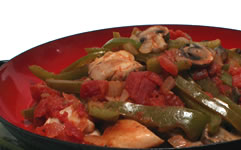If white meat is a healthier choice than red meat, many consumers wonder, “Does that include chicken nuggets?” Are they really a better fast-food choice than burgers?
A portion of five or six chicken nuggets is comparable in many ways to a small hamburger. They are about equal in protein and cholesterol-raising fats (saturated plus trans fats), although the nuggets contain about 20 to 50 fewer calories.
The amount of sodium in chicken nuggets varies widely. Some contain less than a fast-food hamburger loaded with condiments, while others are just as high. If you use a dipping sauce with your nuggets, however, any sodium advantage disappears. With any sauce other than plain honey, they are equal.
If you compare five or six chicken nuggets to an equal portion of hamburger, such as a “single” or quarter-pound burger, the fat and protein issues change.
Compared to the burger, the chicken nuggets supply about half the calories and not much more than half the cholesterol-raising fat. The chicken nuggets are lower in protein than the burger, because so much of their weight is not chicken, but breading. One reason for choosing the chicken nuggets over a burger is to limit red meat.
Regardless of fat or sodium content, experts recommend limiting red meat to a total of no more than three ounces per day to reduce risk of colon cancer, and perhaps some other cancers as well.
However, chicken nuggets are nutritionally different from plain baked or stir-fried chicken. Chicken nuggets can include not just the chicken meat itself but also the skin, with several types of flour, starches and oils.
That makes nuggets higher in calories and about half the protein compared to an equal portion of plain cooked skinless chicken. The biggest differences are in sodium and in saturated plus trans fat, which are 50 percent higher in nuggets than in plain chicken thighs, and more than four times higher than in plain breast.
If you’re eating out, a healthier option is a grilled chicken sandwich. Saturated plus trans fat will be about half that of chicken nuggets. Because of the bun, calories and sodium are no lower. However, a grilled chicken sandwich without added sauce is not much higher in sodium than nuggets plus an order of fries.
Don’t assume that baking frozen chicken nuggets at home makes them healthy choices. Much of the fat and sodium are in the meat mixture and the coating, and are not due to deep-frying. Cookbooks and Internet websites, however, offer ways to make more healthful chicken “nuggets” by baking plain chunks of chicken coated with seasoned corn flake crumbs.
Calorie content may be about the same as commercial chicken nuggets, but this version contains more protein, less total fat and cholesterol-raising fat, and less sodium if you don’t include salt in the coating.
Another alternative is the soy-based nuggets meant to look and taste like chicken nuggets. Here the calories and fat are lower than in commercial chicken nuggets, but the protein and sodium are about the same.
The complete answer about chicken nuggets can’t be found simply by comparing them with these various alternatives. The nutritional impact depends on how the overall meal is put together.
If chicken nuggets are served along with fries and a soda, or packaged macaroni and cheese, all the concerns about chicken nuggets’ content of calories, unhealthy fat and sodium are magnified.
On the other hand, the overall nutrition picture is not nearly so bad if a small portion of those chicken nuggets is accompanied, for example, by a salad, oven-roasted vegetables, fresh fruit, a baked potato, or a whole-grain roll.










